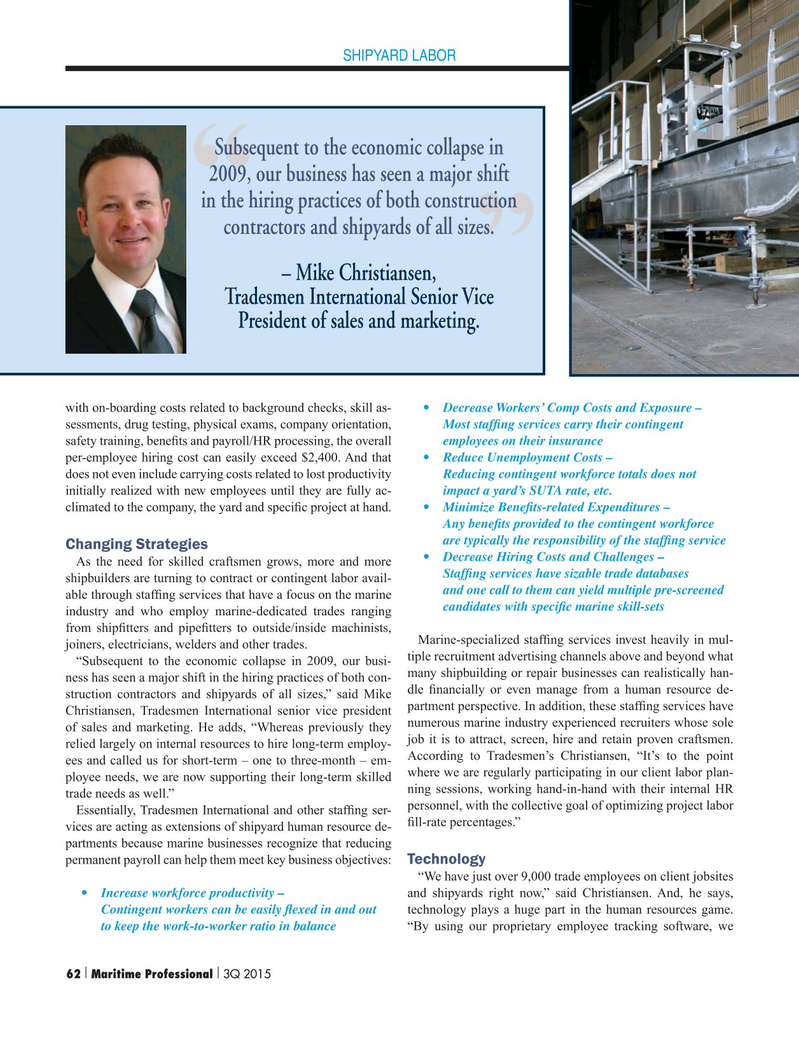
Page 62: of Maritime Logistics Professional Magazine (Q3 2015)
Read this page in Pdf, Flash or Html5 edition of Q3 2015 Maritime Logistics Professional Magazine
SHIPYARD LABOR
Subsequent to the economic collapse in 2009, our business has seen a major shift “ in the hiring practices of both construction contractors and shipyards of all sizes.
” – Mike Christiansen,
Tradesmen International Senior Vice
President of sales and marketing.
with on-boarding costs related to background checks, skill as- • Decrease Workers’ Comp Costs and Exposure – sessments, drug testing, physical exams, company orientation, Most staf? ng services carry their contingent safety training, bene? ts and payroll/HR processing, the overall employees on their insurance per-employee hiring cost can easily exceed $2,400. And that • Reduce Unemployment Costs – does not even include carrying costs related to lost productivity Reducing contingent workforce totals does not initially realized with new employees until they are fully ac- impact a yard’s SUTA rate, etc.
climated to the company, the yard and speci? c project at hand. • Minimize Bene? ts-related Expenditures – Any bene? ts provided to the contingent workforce are typically the responsibility of the staf? ng service
Changing Strategies • Decrease Hiring Costs and Challenges –
As the need for skilled craftsmen grows, more and more Staf? ng services have sizable trade databases shipbuilders are turning to contract or contingent labor avail- and one call to them can yield multiple pre-screened able through staf? ng services that have a focus on the marine candidates with speci? c marine skill-sets industry and who employ marine-dedicated trades ranging from ship? tters and pipe? tters to outside/inside machinists,
Marine-specialized staf? ng services invest heavily in mul- joiners, electricians, welders and other trades. tiple recruitment advertising channels above and beyond what “Subsequent to the economic collapse in 2009, our busi- many shipbuilding or repair businesses can realistically han- ness has seen a major shift in the hiring practices of both con- struction contractors and shipyards of all sizes,” said Mike dle ? nancially or even manage from a human resource de-
Christiansen, Tradesmen International senior vice president partment perspective. In addition, these staf? ng services have of sales and marketing. He adds, “Whereas previously they numerous marine industry experienced recruiters whose sole job it is to attract, screen, hire and retain proven craftsmen. relied largely on internal resources to hire long-term employ-
According to Tradesmen’s Christiansen, “It’s to the point ees and called us for short-term – one to three-month – em- ployee needs, we are now supporting their long-term skilled where we are regularly participating in our client labor plan- ning sessions, working hand-in-hand with their internal HR trade needs as well.” personnel, with the collective goal of optimizing project labor
Essentially, Tradesmen International and other staf? ng ser- ? ll-rate percentages.” vices are acting as extensions of shipyard human resource de- partments because marine businesses recognize that reducing permanent payroll can help them meet key business objectives: Technology “We have just over 9,000 trade employees on client jobsites • Increase workforce productivity – and shipyards right now,” said Christiansen. And, he says, Contingent workers can be easily ? exed in and out technology plays a huge part in the human resources game. to keep the work-to-worker ratio in balance “By using our proprietary employee tracking software, we 62 Maritime Professional 3Q 2015| | 50-63 Q3 MP2015.indd 62 9/18/2015 11:12:09 AM

 61
61

 63
63
